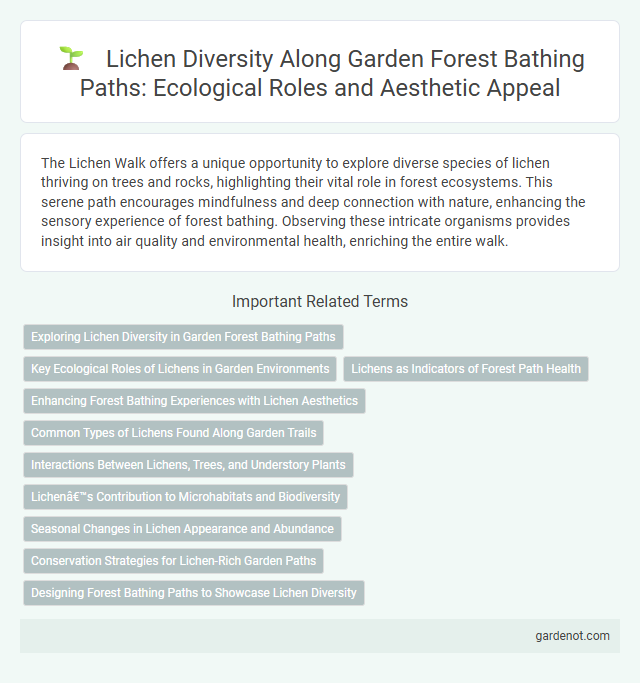The Lichen Walk offers a unique opportunity to explore diverse species of lichen thriving on trees and rocks, highlighting their vital role in forest ecosystems. This serene path encourages mindfulness and deep connection with nature, enhancing the sensory experience of forest bathing. Observing these intricate organisms provides insight into air quality and environmental health, enriching the entire walk.
Exploring Lichen Diversity in Garden Forest Bathing Paths
Lichen diversity thrives along garden forest bathing paths, offering a unique opportunity to explore these symbiotic organisms that blend fungi and algae. Observing various lichen species provides insight into air quality and ecosystem health due to their sensitivity to environmental changes. This immersive lichen walk enhances connection with nature, promoting mindfulness and ecological awareness.
Key Ecological Roles of Lichens in Garden Environments
Lichens play a crucial role in garden ecosystems by enhancing soil quality through nitrogen fixation and organic matter accumulation. Their presence supports biodiversity by providing food and habitat for various invertebrates and microorganisms. Acting as bioindicators, lichens help monitor air quality, contributing to a healthier forest bathing path environment.
Lichens as Indicators of Forest Path Health
Lichens serve as vital bioindicators of forest path health due to their sensitivity to air quality and environmental changes. Monitoring the diversity and abundance of lichen species along a forest bathing path provides valuable insights into ecosystem integrity and pollution levels. The presence of diverse, thriving lichens reflects clean air and minimal disturbance, enhancing the overall ecological value of the trail.
Enhancing Forest Bathing Experiences with Lichen Aesthetics
Lichen-covered trees and rocks create textured landscapes that enrich sensory engagement during forest bathing, promoting mindfulness and relaxation. The diverse colors and intricate patterns of lichens stimulate visual interest, fostering a deeper connection with nature's subtle beauty. Integrating lichen walk routes into forest bathing paths enhances ecological awareness and supports mental well-being through immersive natural aesthetics.
Common Types of Lichens Found Along Garden Trails
Common types of lichens found along garden trails include foliose lichens like Flavoparmelia caperata, crustose lichens such as Graphis scripta, and fruticose lichens exemplified by Evernia prunastri. These lichens thrive on tree bark, rocks, and soil, contributing to the ecosystem by indicating air quality and providing habitat for microfauna. Observing diverse lichen species during a forest bathing path enhances mindfulness and deepens connection to the natural environment.
Interactions Between Lichens, Trees, and Understory Plants
Lichens form a vital symbiotic relationship with trees, serving as bioindicators of air quality while supporting microhabitats in forest ecosystems. Their presence on tree bark enhances moisture retention, benefiting understory plants and promoting biodiversity. Interactions between lichens, trees, and understory vegetation contribute to nutrient cycling and forest health along the Forest Bathing Path.
Lichen’s Contribution to Microhabitats and Biodiversity
Lichens play a crucial role in forest bathing paths by creating diverse microhabitats that support various microorganisms, insects, and small plants. Their presence enhances biodiversity by providing food, shelter, and moisture retention in forest ecosystems. Exploring lichen-covered surfaces along the path reveals intricate ecological relationships vital for sustaining forest health and resilience.
Seasonal Changes in Lichen Appearance and Abundance
Lichen walk offers a unique opportunity to observe seasonal changes in lichen appearance and abundance, with vibrant patches thriving in moist spring and summer conditions. During autumn, lichen coloration shifts subtly while some species exhibit increased reproductive structures, enhancing biodiversity insights. Winter brings a dormancy phase where resilience of hardy lichens becomes evident, highlighting ecosystem stability throughout the year.
Conservation Strategies for Lichen-Rich Garden Paths
Lichen-rich garden paths require conservation strategies that prioritize minimal soil disturbance and controlled foot traffic to preserve delicate lichen colonies. Implementing mulched walkways and designated boardwalks reduces habitat damage and maintains moisture levels essential for lichen growth. Regular monitoring of lichen health and public education about their ecological importance further support the sustainability of forest bathing paths.
Designing Forest Bathing Paths to Showcase Lichen Diversity
Designing forest bathing paths to highlight lichen diversity involves selecting routes rich in varying substrates like tree bark, rocks, and soil where different lichen species thrive. Incorporating educational signage and guided experiences helps visitors recognize lichen's ecological roles as bioindicators of air quality and contributors to nutrient cycling. Strategic path placement enhances biodiversity appreciation while minimizing habitat disturbance, promoting conservation awareness.
Lichen walk Infographic

 gardenot.com
gardenot.com